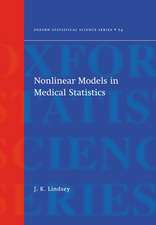Global Behavioral Risk Factor Surveillance
Editat de David V. McQueen, Pekka Puskaen Limba Engleză Paperback – 25 sep 2012
-The U.S.'s Behavioral Risk Factor Surveillance System.
-The Finbalt Health Monitor.
-The EURALIM Experience.
-The Mega Country Health Promotion Network.
-And much more.
This book is for those currently involved in planning or conducting chronic disease risk factor surveillance. It is also a valuable reference for those interested in developing a global network of persons involved in this arena.
"This book is a godsend to those working in the area of monitoring and understanding changes overtime in chronic disease risk factors. It is a collection of 18 chapters authored by experts around the world and provides a comprehensive insight into establishing and maintaining the surveillance of behavioural risk factors both in developed and developing countries."
(Qaiser Mukhtar, Journal of Epidemila Community Health, 59:6)
| Toate formatele și edițiile | Preț | Express |
|---|---|---|
| Paperback (1) | 718.29 lei 6-8 săpt. | |
| Springer Us – 25 sep 2012 | 718.29 lei 6-8 săpt. | |
| Hardback (1) | 728.33 lei 6-8 săpt. | |
| Springer Us – 31 aug 2003 | 728.33 lei 6-8 săpt. |
Preț: 718.29 lei
Preț vechi: 756.09 lei
-5% Nou
Puncte Express: 1077
Preț estimativ în valută:
137.46€ • 142.98$ • 113.48£
137.46€ • 142.98$ • 113.48£
Carte tipărită la comandă
Livrare economică 14-28 aprilie
Preluare comenzi: 021 569.72.76
Specificații
ISBN-13: 9781461349105
ISBN-10: 1461349109
Pagini: 276
Ilustrații: XVII, 255 p.
Dimensiuni: 178 x 254 x 14 mm
Greutate: 0.48 kg
Ediția:Softcover reprint of the original 1st ed. 2003
Editura: Springer Us
Colecția Springer
Locul publicării:New York, NY, United States
ISBN-10: 1461349109
Pagini: 276
Ilustrații: XVII, 255 p.
Dimensiuni: 178 x 254 x 14 mm
Greutate: 0.48 kg
Ediția:Softcover reprint of the original 1st ed. 2003
Editura: Springer Us
Colecția Springer
Locul publicării:New York, NY, United States
Public țintă
ResearchCuprins
1. Introduction. D.V. McQueen, P. Puska. 2. Why is global surveillance necessary? Towards global surveillance of non-communicable disease risk factors: developments and challenges; P. Puska. 3. The who stepwise approach to surveillance (steps) of non-communicable disease risk factors; R. Bonita, et al. 4. Partnerships, strategies, and alliances for global surveillance; V. Lin. 5. Analysis and interpretation of data from the U.S. behavioural risk factor surveillance system (BRFSS); D. Holtzman. 6. Surveillance systems and data analysis: continuously collected behavioural data. British and American samples; S. Campostrini. 7. Finbalt health monitor, monitoring health behaviour in Finland and the Baltic countries; R. Prättälä, et al. 8. Towards a European health monitoring system. Results of a pilot study on physical activity; A. Rütten, et al. 9. Comparison of surveillance data on metropolitan and rural health. Diabetes in southern Australia as an example; D.H. Wilson. 10. Did they use it? Beyond the collection of surveillance information; J.M. Ottoson, D.H. Wilson. 11. Harmonising local health survey data. The EURALIM experience; A. Morabia, et al. 12. Analysis, interpretation, and use of complex social and behavioural surveillance data. Looking back in order to go forward; D.V. McQueen, L. Gauger Elsner. 13. Mega country health promotion network surveillance initiative. Strengthening the capacity of the world's most populous countries to monitor non-communicable disease behavioural risk factors; K.A. Douglas, et al. 14. Epidemiological surveillance system in Latin America andthe Caribbean. Perspectives, challenges, and solutions; L.de Salazar. 15. Creating a synthetic behavioural risk factor index to assess trends in surveillance data. An index of risk forcardio-vascular disease as an example; S. Campostrini, D.V. McQueen. 16. Perspectives on building infrastructure, comparing data, and using surveillance data in developing countries; D.V. McQueen, et al. 17. Non-communicable disease surveillance in Latin America and the Caribbean. Advances supported by the Pan American health organization; S.J. Corber, et al. 18. Perspectives on global risk factor surveillance. Lessons learned and challenges ahead; D.V. McQueen.
Recenzii
"This is the only volume available to address worldwide surveillance, and indeed it may be used immediately by those working internationally with such agencies as the World Bank, US Agency for International Development (USAID), foundations, and others."
(Norma Kanarek, Johns Hopkins Bloomberg School of Public Health in American Journal of Epidemiology, 159:8)
"This book is a godsend to those working in the area of monitoring and understanding changes overtime in chronic disease risk factors. It is a collection of 18 chapters authored by experts around the world and provides a comprehensive insight into establishing and maintaining the surveillance of behavioural risk factors both in developed and developing countries.
(Qaiser Mukhtar, Journal of Epidemiology & Community Health, 59:6)
(Norma Kanarek, Johns Hopkins Bloomberg School of Public Health in American Journal of Epidemiology, 159:8)
"This book is a godsend to those working in the area of monitoring and understanding changes overtime in chronic disease risk factors. It is a collection of 18 chapters authored by experts around the world and provides a comprehensive insight into establishing and maintaining the surveillance of behavioural risk factors both in developed and developing countries.
(Qaiser Mukhtar, Journal of Epidemiology & Community Health, 59:6)












